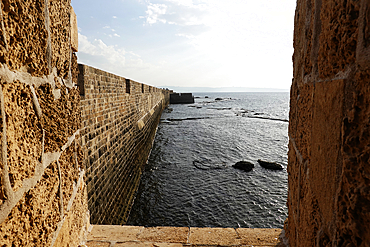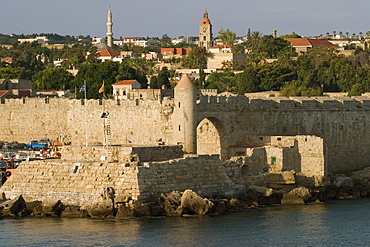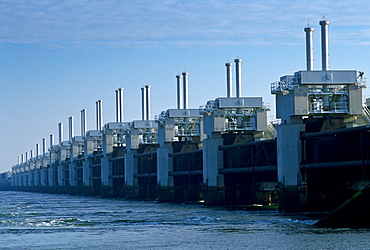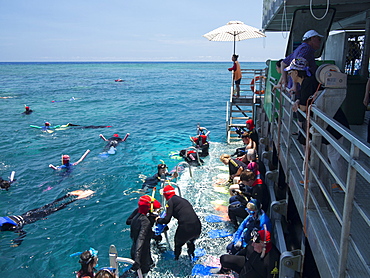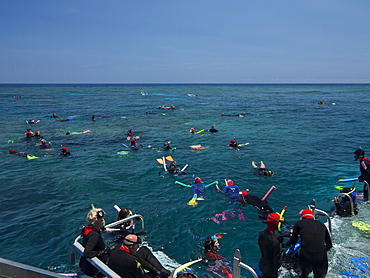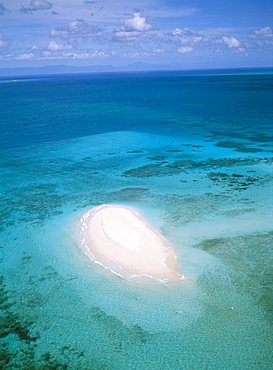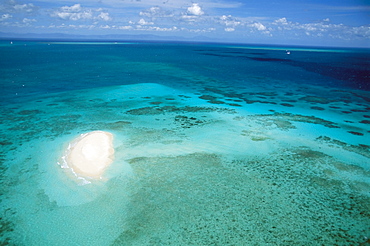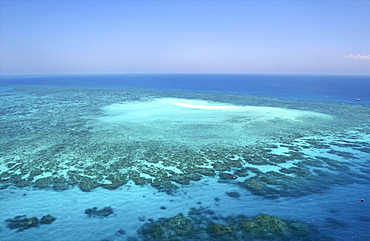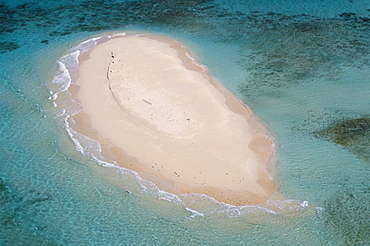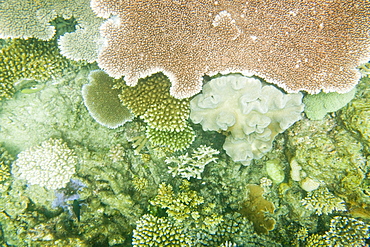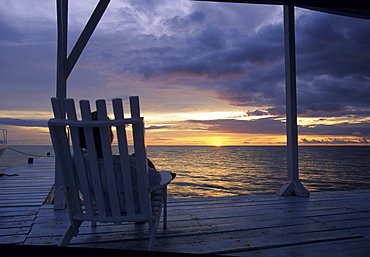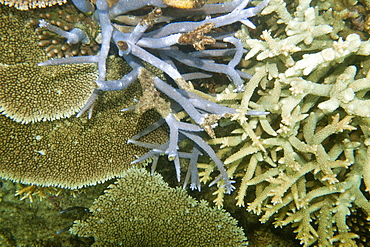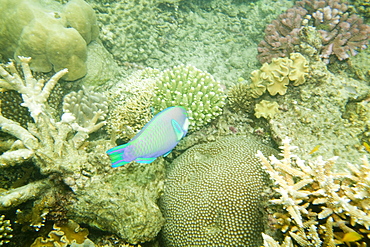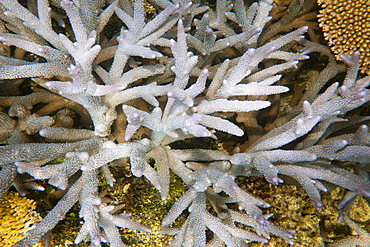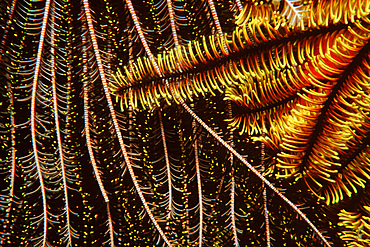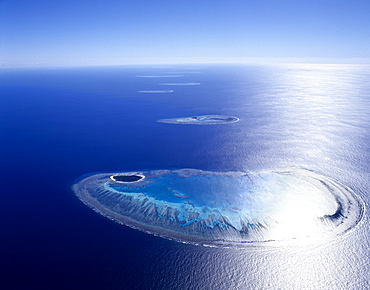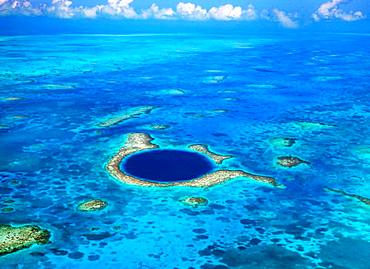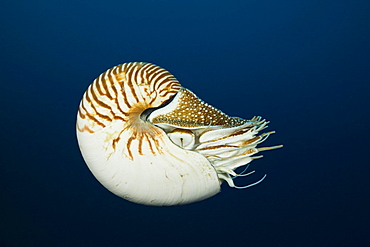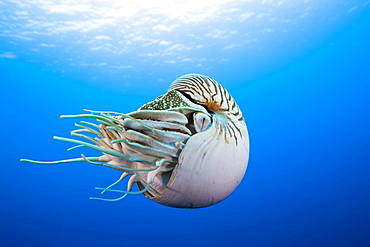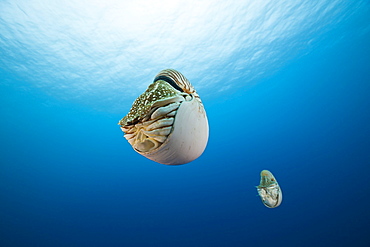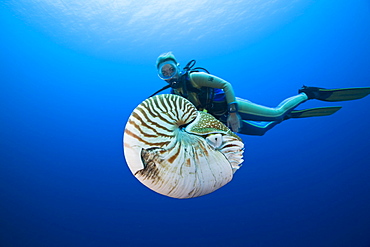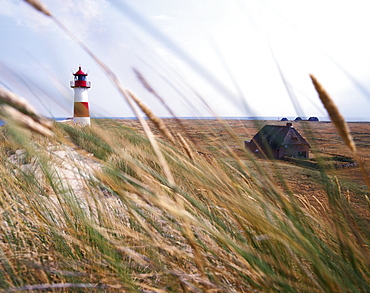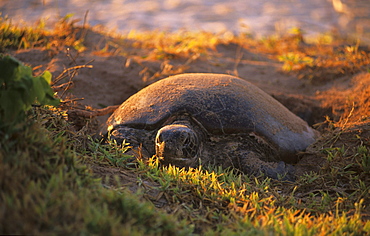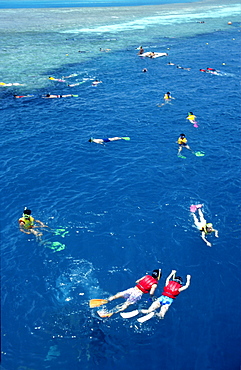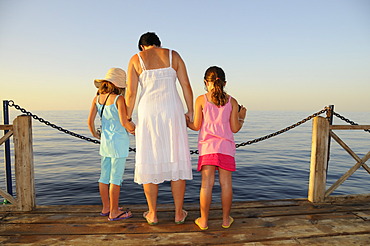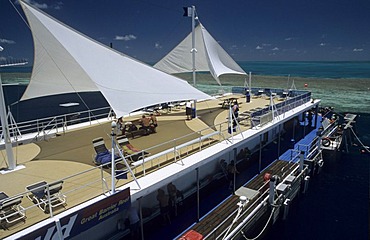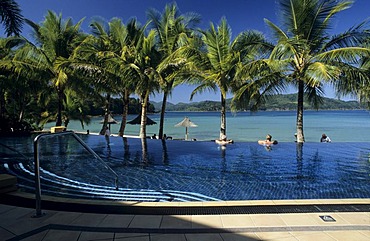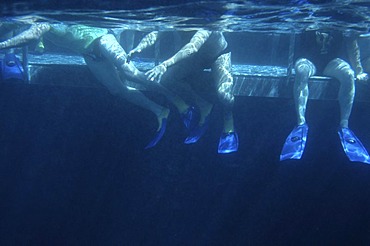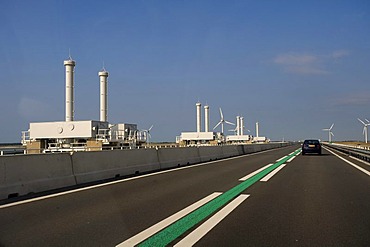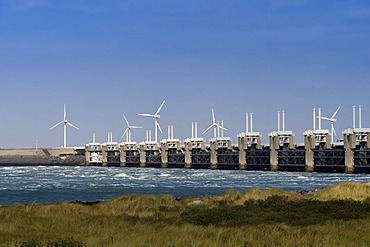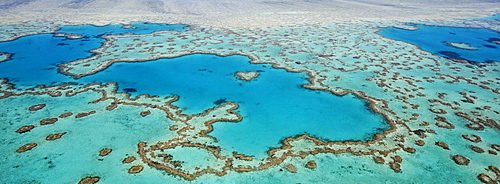Results
« Previous 1 2 3
201 results found

Southern stingray (Hypanus americanus) over sand in shark and ray alley, Caye Caulker, Mesoamerican Barrier Reef, Belize
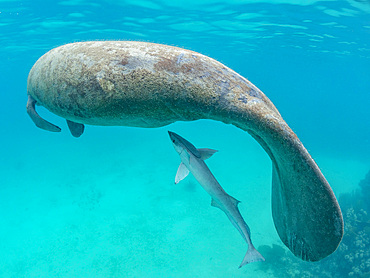
West Indian manatee (Trichechus manatus), with sharksucker, Caye Caulker, inside the Mesoamerican Barrier Reef, Belize
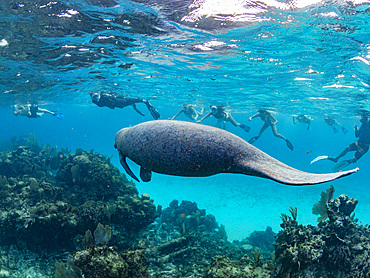
West Indian manatee (Trichechus manatus), with snorkelers near Caye Caulker, inside the Mesoamerican Barrier Reef, Belize
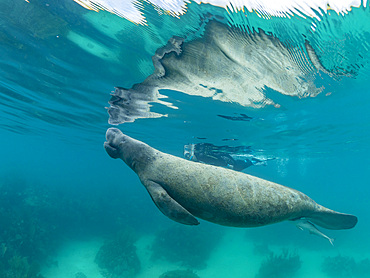
West Indian manatee (Trichechus manatus), with snorkeler near Caye Caulker, inside the Mesoamerican Barrier Reef, Belize
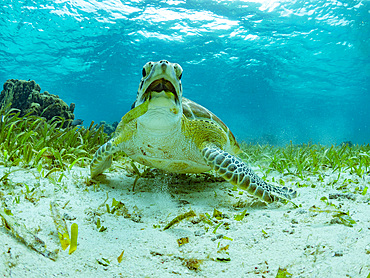
Green sea turtle (Chelonia mydas), feeding on the sand near Caye Caulker, inside the Mesoamerican Barrier Reef, Belize
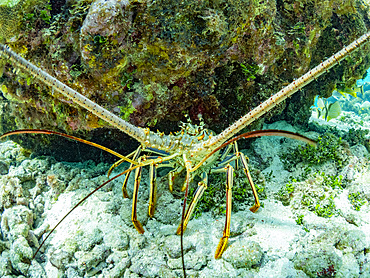
Caribbean spiny lobster (Panulirus argus), underwater at Half Moon Caye, UNESCO, Mesoamerican Barrier Reef, Belize
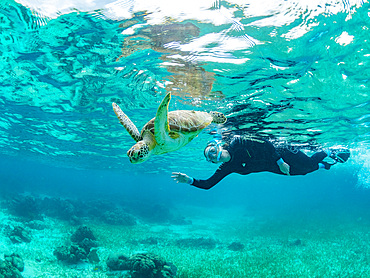
Green sea turtle (Chelonia mydas), with snorkeler near Caye Caulker, inside the Mesoamerican Barrier Reef, Belize

Straw umbrellas on empty white sand beach with clear sea behind, Ilha do Farol, Culatra Barrier Island, Olhao, Algarve, Portugal, Europe
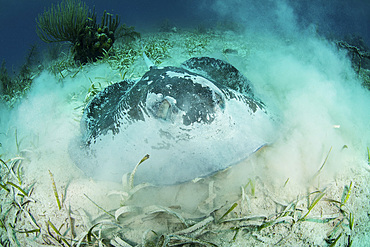
A large roughtail stingray, Dasyatis centroura, lays on the seagrass-covered seafloor of Turneffe Atoll off the coast of Belize. This reef is part of the massive Mesoamerican Reef System in the Caribbean Sea, the second largest barrier reef on Earth.
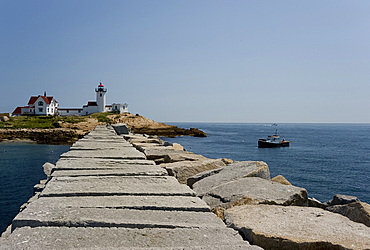
The Eastern Point lighthouse, Gloucester, Massachussetts, New England, United States of America, North America
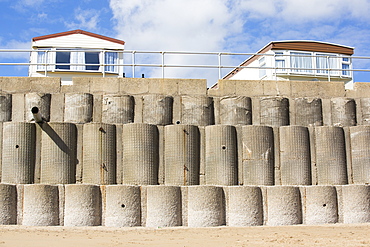
Concrete sea defences at Beach Bank Caravan Park in Ulrome near Skipsea on Yorkshires East Coast, UK. The coast is composed of soft boulder clays, very vulnerable to coastal erosion. This section of coast has been eroding since Roman times, with many villages having disappeared into the sea, and is the fastest eroding coast in Europe. Climate change is speeding up the erosion, with sea level rise, increased stormy weather and increased heavy rainfall events, all playing their part.
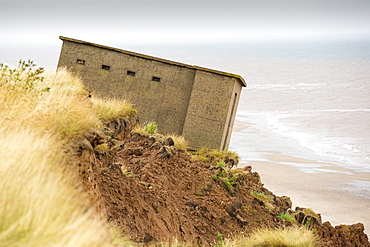
A Second world War lookout post leaning alarmingly and about to tumble over the edge of the cliff near Aldbrough on Yorkshires East Coast, UK. The coast is composed of soft boulder clays, very vulnerable to coastal erosion. This section of coast has been eroding since Roman times, with many villages having disappeared into the sea, and is the fastest eroding coast in Europe. Climate change is speeding up the erosion, with sea level rise, increased stormy weather and increased heavy rainfall events, all playing their part.

The Thames barrier on the River Thames in London. It was constructed to protect the capital city from storm surge flooding. Recent predictions show it will probably be redundant in around twenty years due to increased stormy weather and sea level rise driven by climate change.

The Thames barrier on the River Thames in London. It was constructed to protect the capital city from storm surge flooding. Recent predictions show it will probably be redundant in around twenty years due to increased stormy weather and sea level rise driven by climate change.

The Thames barrier on the River Thames in London. It was constructed to protect the capital city from storm surge flooding. Recent predictions show it will probably be redundant in around twenty years due to increased stormy weather and sea level rise driven by climate change.
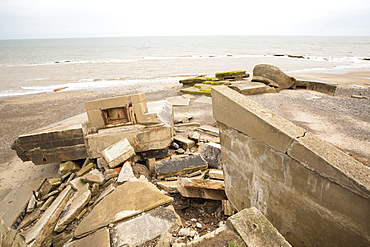
The Remains of the Godwin battery on the beach at Kilnsea at the head of Spurn point on Yorkshires East Coast, UK. Initially constructed during the First World War, the Godwin Battery was added to during the Second World War. It comprised of gun emplacements, search light, barracks, officers’ mess, and a hospital. This section of coastline is the fastest eroding coastline in Europe. The soft boulder clay cliffs are easily eroded and have been eroding since Roman Times, but recently the climate change impacts of increased stormy weather, increased heavy rainfall events and sea level rise have accelerated the rate of erosion. The average rate of attrition is 1.5metres per year, last year it was 5 metres.
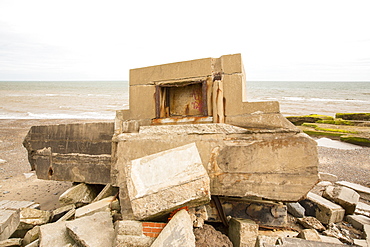
The Remains of the Godwin battery on the beach at Kilnsea at the head of Spurn point on Yorkshires East Coast, UK. Initially constructed during the First World War, the Godwin Battery was added to during the Second World War. It comprised of gun emplacements, search light, barracks, officers’ mess, and a hospital. This section of coastline is the fastest eroding coastline in Europe. The soft boulder clay cliffs are easily eroded and have been eroding since Roman Times, but recently the climate change impacts of increased stormy weather, increased heavy rainfall events and sea level rise have accelerated the rate of erosion. The average rate of attrition is 1.5metres per year, last year it was 5 metres.

Tourists on a semi submersible, viewing the Great Barrier Reef off Cairns in Queensland, Australia, Pacific
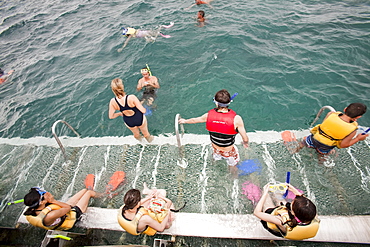
Tourists snorkelling from a dive and snorkel platform anchored to the Great Barrier Reef off Cairns in Queensland, Australia, Pacific
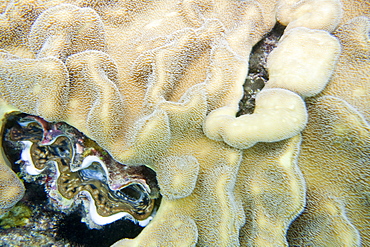
Giant clam amongst the soft coral on the Great Barrier Reef, off Cairns, Queensland, Australia, Pacific
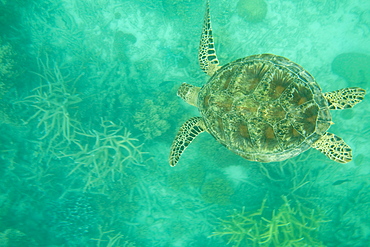
A Green turtle (Chelonia mydas) swimming over the Great Barrier Reef off Cairns, Queensland, Australia, Pacific
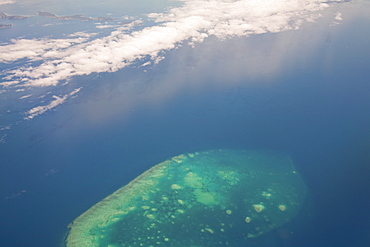
A coral atoll from the air, part of the Great Barrier Reef near Cairns, Queensland, Australia, Pacific
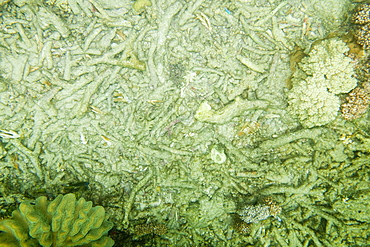
Dead and broken coral on the sea bed, Great Barrier Reef, off Cairns, Queensland, Australia, Pacific
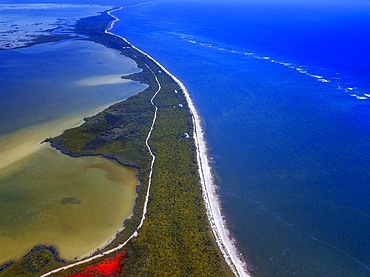
Aerial view of Punta Allen Sian Ka'an Reserve, Yucatan Peninsula, Mexico. Red lagoon near Boca Paila Bridge.
In the language of the Mayan peoples who once inhabited this region, Sian Ka'an means Origin of the Sky. Located on the east coast of the Yucatán peninsula, this biosphere reserve contains tropical forests, mangroves and marshes, as well as a large marine section intersected by a barrier reef. It provides a habitat for a remarkably rich flora and a fauna comprising more than 300 species of birds, as well as a large number of the region's characteristic terrestrial vertebrates, which cohabit in the diverse environment formed by its complex hydrological system.
Along its roughly 120 kilometres of coastline, the property covers over 400,000 hectares of land ranging from sea level to only ten m.a.s.l. The property boasts diverse tropical forests, palm savannah, one of the most pristine wetlands in the region, lagoons, extensive mangrove stands, as well as sandy beaches and dunes. The 120,000 hectares of marine area protect a valuable part of the Mesoamerican Barrier Reef and seagrass beds in the shallow bays. The lush green of the forests and the many shades of blue of the lagoons and the Caribbean Sea under a wide sky offer fascinating visual impressions.
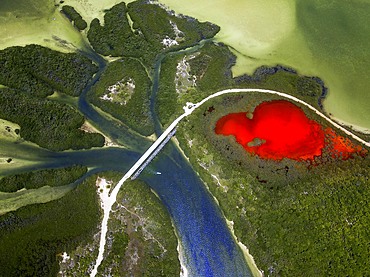
Aerial view of Punta Allen Sian Ka'an Reserve, Yucatan Peninsula, Mexico. Red lagoon near Boca Paila Bridge.
In the language of the Mayan peoples who once inhabited this region, Sian Ka'an means Origin of the Sky. Located on the east coast of the Yucatán peninsula, this biosphere reserve contains tropical forests, mangroves and marshes, as well as a large marine section intersected by a barrier reef. It provides a habitat for a remarkably rich flora and a fauna comprising more than 300 species of birds, as well as a large number of the region's characteristic terrestrial vertebrates, which cohabit in the diverse environment formed by its complex hydrological system.
Along its roughly 120 kilometres of coastline, the property covers over 400,000 hectares of land ranging from sea level to only ten m.a.s.l. The property boasts diverse tropical forests, palm savannah, one of the most pristine wetlands in the region, lagoons, extensive mangrove stands, as well as sandy beaches and dunes. The 120,000 hectares of marine area protect a valuable part of the Mesoamerican Barrier Reef and seagrass beds in the shallow bays. The lush green of the forests and the many shades of blue of the lagoons and the Caribbean Sea under a wide sky offer fascinating visual impressions.
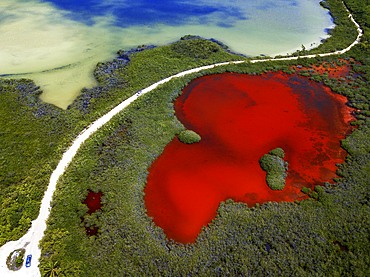
Aerial view of Punta Allen Sian Ka'an Reserve, Yucatan Peninsula, Mexico. Red lagoon near Boca Paila Bridge.
In the language of the Mayan peoples who once inhabited this region, Sian Ka'an means Origin of the Sky. Located on the east coast of the Yucatán peninsula, this biosphere reserve contains tropical forests, mangroves and marshes, as well as a large marine section intersected by a barrier reef. It provides a habitat for a remarkably rich flora and a fauna comprising more than 300 species of birds, as well as a large number of the region's characteristic terrestrial vertebrates, which cohabit in the diverse environment formed by its complex hydrological system.
Along its roughly 120 kilometres of coastline, the property covers over 400,000 hectares of land ranging from sea level to only ten m.a.s.l. The property boasts diverse tropical forests, palm savannah, one of the most pristine wetlands in the region, lagoons, extensive mangrove stands, as well as sandy beaches and dunes. The 120,000 hectares of marine area protect a valuable part of the Mesoamerican Barrier Reef and seagrass beds in the shallow bays. The lush green of the forests and the many shades of blue of the lagoons and the Caribbean Sea under a wide sky offer fascinating visual impressions.
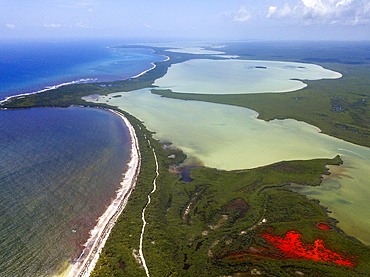
Aerial view of Punta Allen Sian Ka'an Reserve, Yucatan Peninsula, Mexico. Red lagoon near Boca Paila Bridge.
In the language of the Mayan peoples who once inhabited this region, Sian Ka'an means Origin of the Sky. Located on the east coast of the Yucatán peninsula, this biosphere reserve contains tropical forests, mangroves and marshes, as well as a large marine section intersected by a barrier reef. It provides a habitat for a remarkably rich flora and a fauna comprising more than 300 species of birds, as well as a large number of the region's characteristic terrestrial vertebrates, which cohabit in the diverse environment formed by its complex hydrological system.
Along its roughly 120 kilometres of coastline, the property covers over 400,000 hectares of land ranging from sea level to only ten m.a.s.l. The property boasts diverse tropical forests, palm savannah, one of the most pristine wetlands in the region, lagoons, extensive mangrove stands, as well as sandy beaches and dunes. The 120,000 hectares of marine area protect a valuable part of the Mesoamerican Barrier Reef and seagrass beds in the shallow bays. The lush green of the forests and the many shades of blue of the lagoons and the Caribbean Sea under a wide sky offer fascinating visual impressions.

Palms and old pier in Punta Allen Sian Ka'an Reserve, Yucatan Peninsula, Mexico.
In the language of the Mayan peoples who once inhabited this region, Sian Ka'an means Origin of the Sky. Located on the east coast of the Yucatán peninsula, this biosphere reserve contains tropical forests, mangroves and marshes, as well as a large marine section intersected by a barrier reef. It provides a habitat for a remarkably rich flora and a fauna comprising more than 300 species of birds, as well as a large number of the region's characteristic terrestrial vertebrates, which cohabit in the diverse environment formed by its complex hydrological system.
Along its roughly 120 kilometres of coastline, the property covers over 400,000 hectares of land ranging from sea level to only ten m.a.s.l. The property boasts diverse tropical forests, palm savannah, one of the most pristine wetlands in the region, lagoons, extensive mangrove stands, as well as sandy beaches and dunes. The 120,000 hectares of marine area protect a valuable part of the Mesoamerican Barrier Reef and seagrass beds in the shallow bays. The lush green of the forests and the many shades of blue of the lagoons and the Caribbean Sea under a wide sky offer fascinating visual impressions.
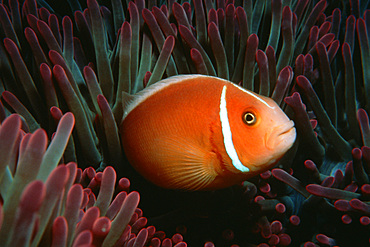
Pink anemonefish, Amphiprion perideraion, in sea anemone, Great barrier reef marine park, Australia (South Pacific).
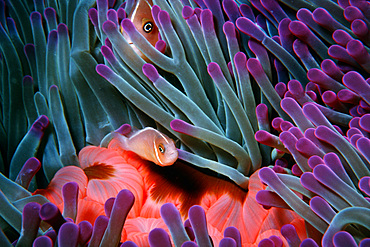
Juvenile and adult pink anemonefish in sea anemone, Amphiprion perideraion, Fila Reef, Port Vila, Vanuatu (S. Pacific).
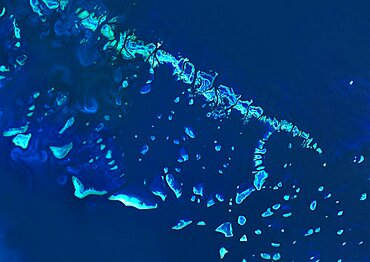
Satellite view of the Great Barrier Reef, Australia, off Mackay's coast. This image was compiled from data acquired in 2014 by Landsat 8 satellite.
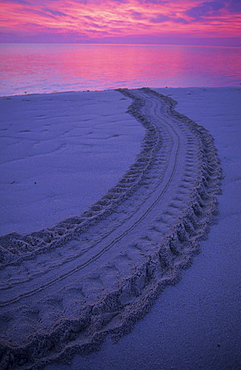
Tracks of a sea turtle which has returned to the ocean after laying her eggs, Heron Island, Great Barrier Reef, Australia
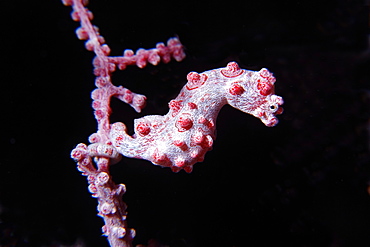
Pygmy seahorse (Bargibanti hippocampus) on a branch of coral, Great Barrier Reef, a UNESCO World Heritage Site, Queensland, Cairns, Australia, Pacific Ocean
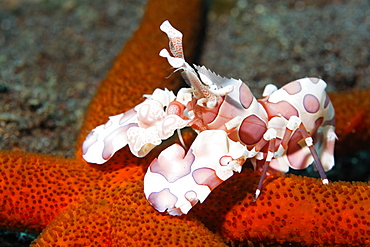
Harlequin shrimp (Hymenocera picta) on a red starfish, Great Barrier Reef, a UNESCO World Heritage Site, Queensland, Cairns, Australia, Pacific Ocean
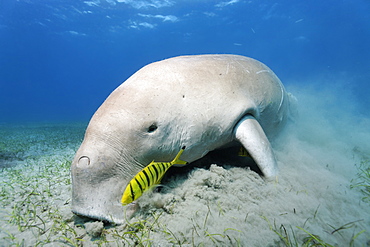
Dugong (Dugong dugon), feeding on sea weed, Golden Trevallys (Gnathodon speciosus), Pilot Fish, Great Barrier Reef, UNESCO World Heritage Site, Queensland, Cairns, Australia, Pacific Ocean
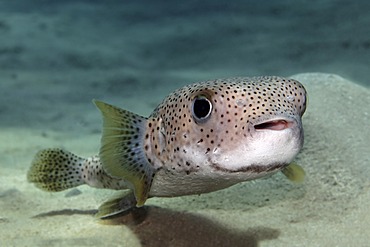
Spot-Fin Porcupine Fish (Diodon hystrix) swimming above the sandy bottom, Great Barrier Reef, UNESCO World Heritage Site, Queensland, Cairns, Australia, Pacific Ocean
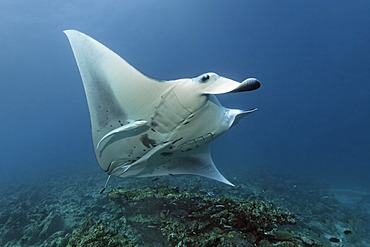
Manta Ray (Manta birostris) with Remora (Echeneis naucrates) swimming above coral reef to cleaning station, Great Barrier Reef, UNESCO World Heritage Site, Cairns, Queensland, Australia, Pacific
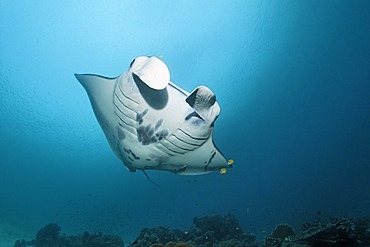
Reef manta ray (Manta alfredi) swimming above a coral reef, Great Barrier Reef, UNESCO World Heritage Site, Queensland, Cairns, Australia, Pacific Ocean
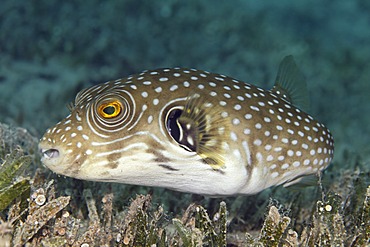
White-spotted Puffer (Arothron hispidus) swimming above sea grass, Great Barrier Reef, UNESCO World Heritage Site, Queensland, Cairns, Australia, Pacific Ocean

Oceanic Whitetip Shark (Carcharhinus longimanus) in blue water, shadow of boat in the back, Great Barrier Reef, UNESCO World Heritage Site, Cairns, Queensland, Australia, Pacific

Dugong (Dugong dugon) feeding on seagrass bed, with Golden Trevallys (Gnathanodon speciosus), Great Barrier Reef, UNESCO World Heritage Site, Cairns, Queensland, Australia, Pacific
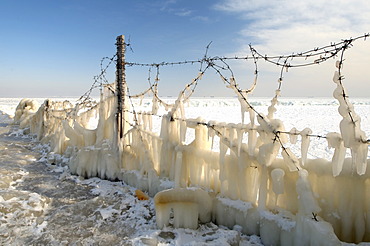
Icy barbed wire, frozen Black Sea, a rare phenomenon, occured in 1977 for the last time, Odessa, Ukraine, Eastern Europe
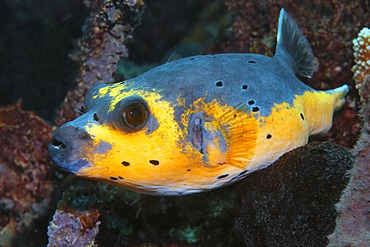
Blackspotted Puffer (Arothron nigropunctatus, Arothron citrinellus), yellow variety, swimming in coral reef, Great Barrier Reef, UNESCO World Heritage Site, Cairns, Queensland, Australia, Pacific
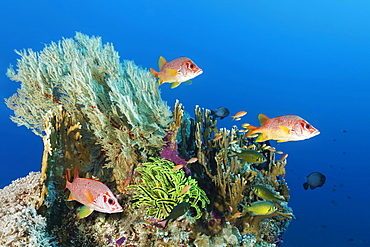
Coral block with different stony corals (Scleractinia), Melithaea gorgonian (Melithaea sp.), Feather star, yellow (Crinoidea) and Sabre squirrelfish (Sargocentron spiniferum), three, Great Barrier Reef, Coral Sea, Pacific, Australia, Oceania

Eider Barrier on the mouth of River Eider near Toenning - largest German coastal protection building, Schleswig-Holstein, Germany
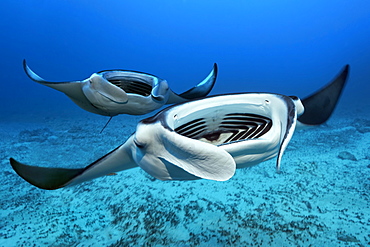
Two Reef manta rays (Mobula alfredi) swims with open mouth over sandy bottom, from the front, Great Barrier Reef, Coral Sea, Pacific Ocean, Australia, Oceania
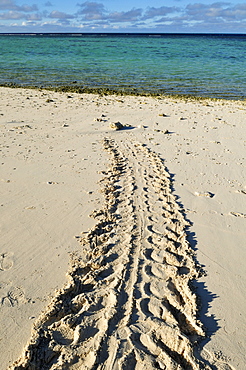
Track of a green sea turtle on the beach of Heron Island, Capricornia Cays National Park, Great Barrier Reef, Queensland, Australia
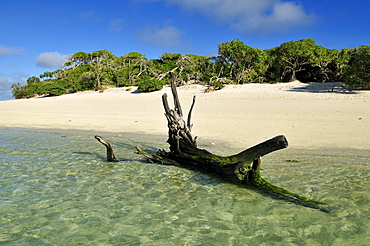
Driftwood on a sandy beach of Heron Island, Capricornia Cays National Park, Great Barrier Reef, Queensland, Australia
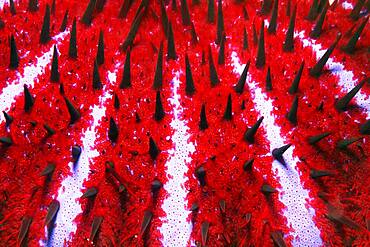
Detail of toxic Crown-of-thorns starfish (Acanthaster planci), spines, crown of thorns, Pacific, Great Barrier Reef, UNESCO World Heritage, Australia, Oceania

Pilot Fish (Naucrates ductor) swimming in front of mouth, reef manta ray (Mobula alfredi) with curled up head fins, Great Barrier Reef, Coral Sea, Pacific Ocean, Australia, Oceania

Aerial view of the ocean floor, Heart Reef, heart-shaped reef, Great Barrier Reef World Heritage Area, Great Barrier Reef, UNESCO World Heritage Site, Queensland, South Pacific, Australia
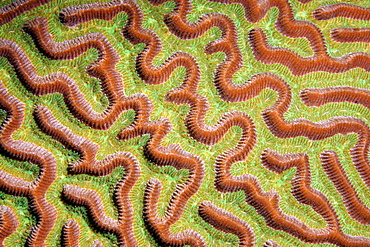
Graphic detail of the Brain Coral (Colpophyllia natans) with twists and withdrawn polyps, Barrier Reef, San Pedro, Ambergris Cay Island, Belize, Central America, Caribbean
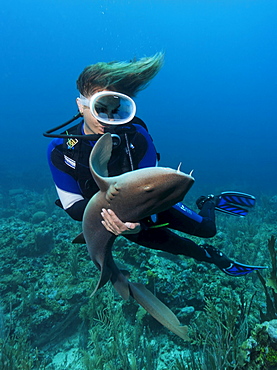
Female scuba diver holding a Caribbean Nurse Shark (Ginglymostoma cirratum), special contact on the sharks belly causes it to fall into a state of apathy, Barrier Reef, San Pedro, Ambergris Cay Island, Belize, Central America, Caribbean

Aerial view of the ocean floor, Heart Reef, heart-shaped reef, Great Barrier Reef World Heritage Area, Great Barrier Reef, UNESCO World Heritage Site, Queensland, South Pacific, Australia
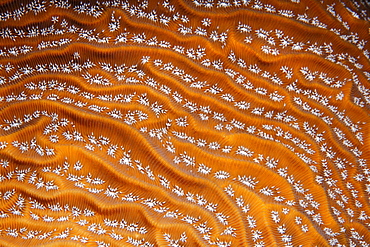
Graphic detail of Graham's Leafy Coral (Agaricia grahamae), Barrier Reef, San Pedro, Ambergris Cay Island, Belize, Central America, Caribbean
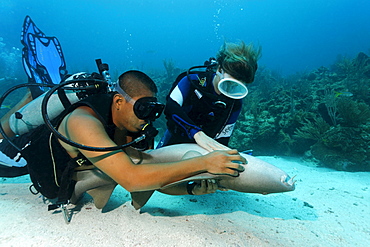
Scuba diver and her dive master caressing the underside of a Nurse Shark (Ginglymostoma cirratum) in way that causes the shark to fall into a state of apathy, barrier reef, San Pedro, Ambergris Cay Island, Belize, Central America, Caribbean
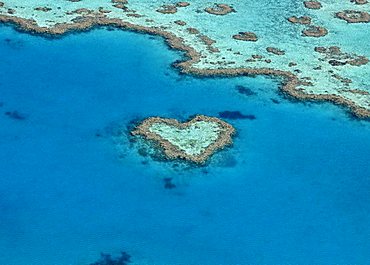
Aerial view of the ocean floor, Heart Reef, heart-shaped reef, Great Barrier Reef World Heritage Area, Great Barrier Reef, UNESCO World Heritage Site, Queensland, South Pacific, Australia

Graphic detail of a Favia Coral (Solanestrea sp.) with blossoming coral polyps, Barrier Reef, San Pedro, Ambergris Cay Island, Belize, Central America, Caribbean
